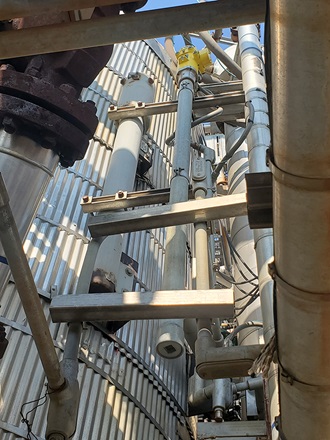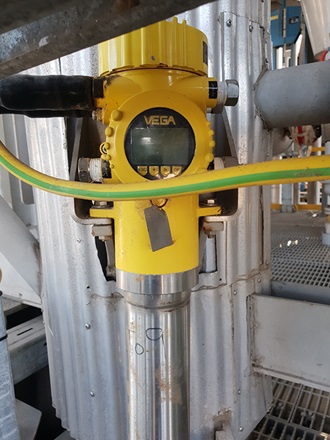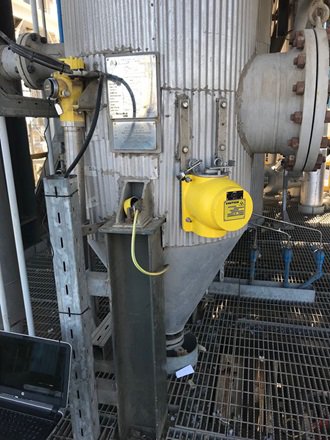Improving Level Control in the CCR and PDH Unit with Non-Intrusive Radiometric Instruments from VEGA
In the refining and petrochemical industries, metal catalysts are used in the conversion of feedstocks to desired products. These catalysts become fouled and/or degraded through the chemical conversion process, and must be regenerated as part of the continuous use processes.
In these process train operations there is often included a Continuous Catalyst Regeneration (CCR) unit that is tasked with taking spent catalyst from the conversion unit, regenerating the reactivity of the catalyst and returning the recovered catalyst back to the operating unit.
Specifically, we see these units included in Catalytic Reforming within refineries and Propane Dehydrogenation (PDH) units within petrochemical plants with polypropylene (PP) production. For the CCR processes we typically see the radiometric instruments applied to AXENS – Aromizing™ and Universal Oil Products (UOP) - PlatformingTM & Oleflex™ license packages. The advent of this technology has addressed a growing environmental problem and significantly improved industry economics which is why as of today, more than 500 units have been licensed worldwide.
Non-contacting Measurements to Support High Temperature and Erosive Process
Radiometric technology is the most reliable form of instrumentation used in the CCR since it is non-contacting to the process and not exposed direction to the high temperatures and abrasive conditions in the CCR. The function of VEGA’s radiometric instruments is to provide inventory control of catalyst coming from the process unit and to control batched volumes as it passes through the regeneration process which ensures catalyst re-activation is continuous and reliable. The purpose of controlling the batched volumes has two reasons: the first is to ensure that the catalyst is entirely regenerated before re-introduction to the operating process unit & the second is to maintain minimum pressure drop between vessels in the CCR, so that the material proceeds through the unit without added unwanted mechanical force.
The CCR consists of multiple vessels, the first of which is the Spent Catalyst Disengaging Hopper which receives spent catalyst from the production unit. This vessel operates at high temperature, similar to that of the operating process, so care should be taken to prevent heat transfer from the vessel to the instrumentation at the point of installation. In this vessel there is a continuous level measurement that acts as an inventory control of the surge zone. The level measurement can be made with VEGA’s patented FIBERTRAC 31 with flexible fiberoptic bundle or the SOLITRAC 31 with maximum sensitivity. The MINITRAC 31 is a low limit switch that initiates opening & closure of a valve to move the spent catalyst into the regeneration zone of the CCR by gravity feed is also necessary to ensure safe prevention of the empty condition. The location of the radioactive source as it relates to the measurement ranges for the continuous level and switch points defined by the process licensor is very important to ensure proper unit performance.
The spent catalyst then moves to the regeneration section of the unit where the catalyst is cleaned of process deposits and where chemical activation will occur. Similarly, a continuous level measurement and low level switch are used to control the batch of catalyst as it proceeds through the CCR. The radiometric point level measurements in particular can be calibrated to change state at very specific conditions against the mounding of the catalyst material. This allows for optimized process control of the regeneration process.
Once the “like new” catalyst reaches the final stage it is captured and stored in the Regenerated Catalyst Storage Hopper. From here it will be re-introduced to the operating unit via pressurized gas flow, in a batching method to ensure the proper volume of catalyst remains inside the operating vessels. Radiometric level and point level instruments are used to ensure optimal utilization of regeneration capacity and efficient usage of regenerated catalyst volume.
There are additional lock hopper vessels that accept reprocessed catalyst as it passes between the Regenerator and the Regenerated Catalyst storage vessel that also utilize radiometric instrumentation. The function again is to maintain a pressure barrier between upstream and downstream vessels. The pressure differential comes from the higher pressure needed to push the regenerated catalyst back into the operating vessel.
Radiometric Measurement to Support Material Mass Flow and Pressure Balance
VEGA’s PROTRAC Series of radiometric instrumentation is well designed for the unique demands in the CCR unit. These radiation-based sensors enable precise measurement of bulk solids under extreme process conditions such as high temperatures and highly erosive environments in the material flow of metal catalysts. Since the instrumentation is non-contacting to the process, for new or existing projects, radiometric instruments can be added without vessel modification and installed while the unit is in operation. The measuring principle offers maximum operational safety and reliability, while requiring no maintenance or recalibration. It is through VEGA’s decades of industry experience instrumenting CCR’s worldwide, strong end user and process licensor relationships that has made VEGA the industry leader for level and density instrumentation in the refining and petrochemical industry.
Related industries

Refining and petrochemical
Related applications
Continuous catalyst regeneration
Level measurement and point level detection of catalyst
Platformers and reformers, both catalyst-based processes, require “fresh” catalyst at a given point in their cycle. To provide fresh catalyst without shutting down the process, a continuous catalyst regeneration unit can be installed. This unit regenerates the spent catalyst so that it can be used again. Maintaining the proper level in the vessel ensures that the expensive catalyst is used at the highest level of efficiency without waste.

Reliable
Non-invasive measurement ensures high plant availability
Cost effective
Lightweight design reduces mounting costs
User friendly
External mounting does not interrupt the process
Related products
Export this article
Download as PDFShare this article
Comments ({{comments.length}})
{{getCommentAuthor(comment, "Anonymous")}} {{comment.timestamp | date : "dd.MM.yyyy HH:mm" }}
{{comment.comment}}








